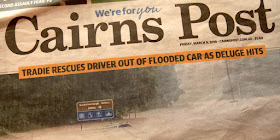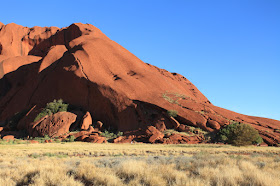The South Island
Landing first in Christchurch, there is still evidence everywhere of the 2010-2011 earthquake swarm. What began as a memorial to the 185 persons who lost their lives on the February 22, 2011 M6.7 quake, is now a permanent art piece constructed of 185 empty chairs.
The cathedral in Christchurch was very badly damaged and the city has been agonizing for seven years what to do with the former city centerpiece.
Recently, the city fathers and the Anglican Church have decided that the city icon will be restored.
Leaving Christchurch, we head south across the flat Canterbury Plains and into the rolling Mackenzie Basin country.
...and this church sits on the shores of a great glacial lake, Lake Pukaki, covering nearly 69 square miles. It is very picturesque. The South Island is rife with glacial features.
We are now in Mt. Cook National Park and are driving in a 4X4 vehicle up to the Tasman Glacier. The ridge of rock on the right of the road is a lateral moraine from the glacier.
On the way up the valley we saw huge avalanche chutes filled with boulders. Some of them like this looked very fresh.
I have now climbed to near the top of the lateral moraine and the view is up valley. The skyline of the Southern Alps can be seen in the far distance.
Once at the top of the moraine we got a fine view of the Tasman Glacier, covered in rocky debris as the glacier ablates. In 1973 the snout of this glacier was four miles farther downstream...
...way out of sight in this downstream view. The Tasman Glacier is a rapidly retreating ice sheet and in 1973 this lake did not exist - the valley floor was covered in ice.
Close-up of the glacier snout and its rocky mantle.
Close-up of the lateral moraine ridge.
We got some excellent view of Mt. Cook from the large windows of the hotel. This lenticular cloud never went away but still, this is considered a clear day. (The next day was overcast). Mt. Cook is New Zealand's highest peak at 12,218 ft. Prior to December, 1991, it was 31 feet higher but a rock and ice fall shaved the 31 feet off of its total height.
Leaving Mt. Cook for Queenstown we passed the gold mining village of Arrowtown, established in 1862.
Most of the rocks used for walls are local stone made of schist.
An Arrowtown store hawking local gold. The gold was emplaced in the early part of the Cenozoic Era.
This is Mirror Lake in the Fiordland National Park containing 2.9 million acres of preserved wet forest lands.
On the Chasm Trail, we were treated to a lush fern tree forest!
They are magnificent plants. There are over 200 types of native ferns in New Zealand and 70 introduced species. About 40% of the native ferns occur nowhere else in the world.
Some tree ferns can grow as tall as 30 feet. They are reminiscent of a much earlier time in earth history and the word that drifted through my mind as I wandered beneath them was "Jurassic."
Another important green treasury on the South Island is the mineral jade (nephrite, and bowenite). The Maori people had/have a multitude of uses for jade.
It rains a lot in Fjordland with over 200 days per year of rainfall and sometimes measuring 8 meters in a single year and about 320 inches! For that reason, Mitre Peak seen above is difficult to get a good shot. This peak is as iconic to the people of New Zealand as the Grand Canyon or Golden Gate Bridge is to Americans.
We saw some rain here in the very southern parts of the South Island but on our last day, we woke up to a bluebird day! Overnight, snow had fallen in The Remarkables, the range found on the south side of Queenstown.
We took a ride on the Earnslaw steamer ship, which was put into service the same year as the Titanic. Needless to say, this ship has had a longer run. Our trip to the South Island was very enjoyable! Now it was on to the North Island.
The North Island
Flying north, we got a great view of the Southern Alps, fresh with snow.
Somewhere out there is Mt. Cook in the high clouds. Low clouds fill the glacial valleys.
First stop is the geyser area in Rotorua (meaning Two Lakes in the Maori language). It was interesting - in Australia there were over 400 languages among the Aborigines. Here, across both islands, the people were united in a single language of Polynesian descent.
This is the Pohutu Geyser erupting. Watch a 4-minute YouTube video of the geyser erupting (note that the video begins in Russian but there is some English in it. Excellent footage of a big eruption. It's all about the geological plumbing in these systems.
Thermal pool near Pohutu.
A sulphur deposit surrounding a steam vent.
Ahh - the boiling mudpots, one of my favorite thermal features! These multi-storied pots were most fascinating.
This two photo sequence shows two small bubbles on the right that had just plopped and the larger one of the left in the act of plopping.
You got to be quick but I captured a bubble in mid-plop. I could watch these features for hours. Gases coming up through fractures in the rock thermally alter the rock and break it down. Hot water mixes with the decomposed rock to create the mud. Geothermal heat drives the boil.
Hangi is the Maori tradition of cooking food in a hot pit and we were able to taste the results.
A Maori warrior.
The Waitomo Caves are a great limestone cavern system located halfway between Rotorua and Auckland. This limestone is a mere 30 million years old and formed when this portion of Zealandia was submerged. Zealandia is the no-so-micro microcontinent. The continental crust here is half the size of Australia but only a small portion of it is emergent.
Cave formations. I set my ISO number to 6400 and there white balance on cloudy. It worked really well. My camera does not have a flash.
Bacon rind formation. or curtain formation with light filtering through it.
These caves are famous for the glow worms, actually a larvae. Check it out here. Shown here are the "food traps" they weave from the cave ceiling.
I managed to get a poor image of four glow worms.
Fossilized pectin shell in limestone.
Our last stop was in New Zealand's largest city, Auckland, population 1,300,000 people. It is a beautiful city located on a narrow peninsula between the Pacific Ocean and the Tasman Sea.
If you ever go to Auckland, I highly recommend a visit to the National Museum where we saw specimens of some of New Zealand's famous fossils - the nine species of large flightless birds called moas. They were ratites related to the Australian emu, the South America rhea, and the African ostrich. Overhunting by the colonizing Maori sent them to extinction within 150 years of their arrival by about 1250 AD.
This was the largest Moa, (Dinomis robustus) and stood twelve feet tall.
The old ferry building in Auckland where I caught the 15 minute ferry ride to Devonport.
In Devonport I climbed to the top of Mt. Victory for this sweeping view of the harbor in Auckland. That island is Rangitoto, a cone volcano that erupted about 550 years ago. Maori legends speak to the eruption, witnessed by many, This ends my discussion of my 2018 Smithsonian Journey's trip to Australia and New Zealand. Thanks as always for reading!



































































































